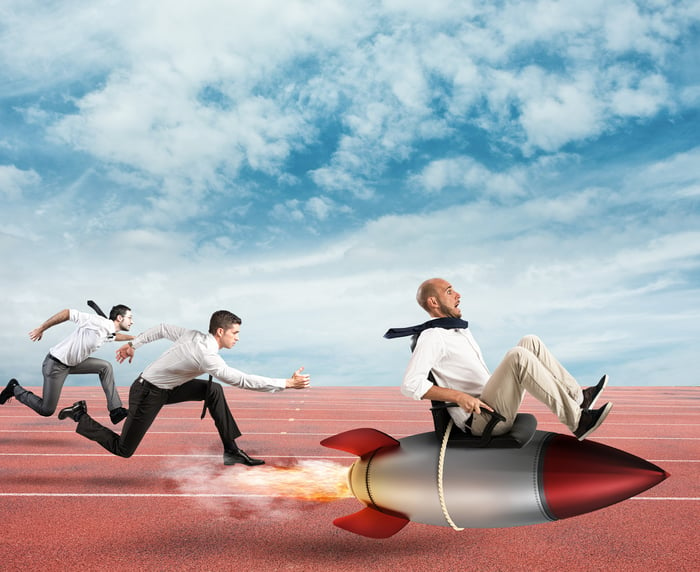You know how they say that "imitation is the sincerest form of flattery"? Well, Elon Musk must be feeling very flattered today.
For 54 years, the Soviet Union and then Russia have been flying variants of their "Soyuz" rocket to send astronauts, satellites, and cargo to space. Last week, though, Russian Space Agency Roscosmos announced that it will design and build a new space rocket -- a new reusable space rocket -- dubbed the "Amur" to carry Russia's space program through the rest of the 21st Century.
Reading through the details of the new methane-oxygen-powered rocket, described in a combination press release-interview story by Russian state news agency TASS, it's impossible to miss the similarities to Elon Musk's fleet of Falcon 9 rockets at SpaceX -- or the dissimilarities to anything produced by Boeing (BA 1.76%) or Lockheed Martin (LMT -0.11%).
Here's what we know about Russia's new Amur.

Image source: Getty Images.
The name
Russia's new rocket will be named for the region from which it will launch -- Amur Oblast in Russia's Far East. Probably not coincidentally, this is the location of Russia's newest spaceport, the Vostochny Cosmodrome, near the border with China.
The specs
Amur will be designed with an optionally reusable first stage powered by five RD-0169A methane-oxygen engines, and an expendable second stage with a sixth, vacuum-rated RD-0169V engine. After launch, the first-stage booster will land back on Earth, slowed and guided en route by gridlike "fins" -- just like SpaceX's Falcon first stages. (Roscosmos also mentions the possibility of first stages landing "like an airplane" with the use of "folding wings" -- but that would seem more of a backup plan in case Roscosmos cannot master landing on retrorockets.)
Either way, because Vostochny is an inland site, located several hundred miles from the sea, Amur first stages will only land on solid ground. At this time, Russia has no plans to build SpaceX-like drone ships for landings at sea, due to frequently adverse weather conditions in the Sea of Okhotsk.
That's the first big difference between Amur and SpaceX's Falcon 9 -- and it will flatten Roscosmos's learning curve, because land landings are easier than hitting a moving target on water. Another difference is size. With a 55-meter height and a 4.1-meter diameter, Amur will be shorter, but a bit squatter, than SpaceX's Falcon 9. Despite its wider stance, Amur's payload fairing (the "capsule" that contains the satellites, astronauts, or other cargo) will be slightly smaller than Falcon 9's -- just 5.1 meters in diameter.
To maximize what Amur can carry within that smaller fairing, the Russian rocket will load itself with super-cooled propellant to maximize its fuel load.
The payload
Despite steps like these, however, it's clear Amur will be a less robust rocket than SpaceX's Falcons. At best, Amur will carry only about the payload of an ordinary United Launch Alliance Delta IV -- just 12.5 tons to Low Earth Orbit in a fully expendable configuration, or 10.5 tons reusable. For this reason, Roscosmos characterizes Amur as initially being only a "light-lift" or "medium-lift" rocket.
The price
That's not necessarily a bad thing. As Roscosmos future programs and science executive director Alexander Bloshenko explains, more than half of all commercial rocket launches today are light- and medium-lift -- a number he predicts will only grow over time. Accordingly, Bloshenko hopes to capture "a large part of commercial launches in the light and medium class."
Helping it to capture the market will be a lower launch cost. Roscosmos envisions spending no more than $910 million developing Amur. By keeping a tight rein on costs and focusing on creating "a competitive commercial product," Bloshenko says Roscosmos will be able to charge just $22 million for launches, undercutting SpaceX's $62 million advertised price. If this proves accurate, Roscosmos could well steal away SpaceX's international business -- which in fact appears to be the goal.
But SpaceX wouldn't be the only victim.
For several years now, Boeing and Lockheed's ULA has been trying to build a commercial space business of its own to lessen its reliance on government contracts. ULA has made admirable progress in cutting costs already, and hopes to one day to launch its new Vulcan family of rockets for under $100 million.
$22 million rocket launches from Roscosmos, however, could smother those hopes in their cradle. Things were bad enough when ULA only had to compete with reusable rockets from SpaceX. If a price war breaks out between SpaceX and Roscosmos, however, ULA's entirely expendable space business could become collateral damage.
The timeline
When will all of this happen? How soon do Boeing and Lockheed need to start worrying about Roscosmos? The company doesn't plan to conduct its first test flight until 2026 -- but Bloshenko is so confident in its success that he says the rocket will carry a payload "immediately" on this first test flight.
With a price war in rocket launch breaking out, it would appear time is running out for ULA to invent a reusable rocket of its own.





